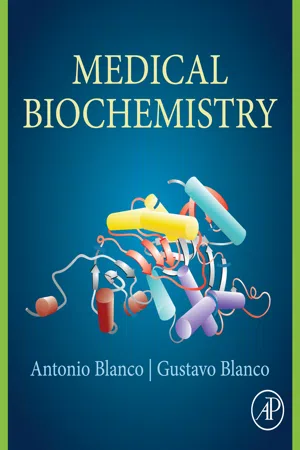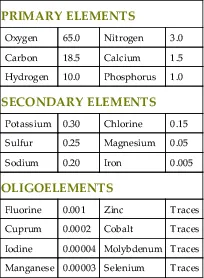
eBook - ePub
Medical Biochemistry
Antonio Blanco, Gustavo Blanco
This is a test
Buch teilen
- 826 Seiten
- English
- ePUB (handyfreundlich)
- Über iOS und Android verfügbar
eBook - ePub
Medical Biochemistry
Antonio Blanco, Gustavo Blanco
Angaben zum Buch
Buchvorschau
Inhaltsverzeichnis
Quellenangaben
Über dieses Buch
Medical Biochemistry is supported by over forty years of teaching experience, providing coverage of basic biochemical concepts, including the structure and physical and chemical properties of hydrocarbons, lipids, proteins, and nucleotides in a straightforward and easy to comprehend language. The book develops these concepts into the more complex aspects of biochemistry using a systems approach, dedicating chapters to the integral study of biological phenomena, including particular aspects of metabolism in some organs and tissues, and the biochemical bases of endocrinology, immunity, vitamins, hemostasis, and apoptosis.
- Integrates basic biochemistry principles with molecular biology and molecular physiology
- Provides translational relevance to basic biochemical concepts though medical and physiological examples
- Utilizes a systems approach to understanding biological phenomena
Häufig gestellte Fragen
Wie kann ich mein Abo kündigen?
Gehe einfach zum Kontobereich in den Einstellungen und klicke auf „Abo kündigen“ – ganz einfach. Nachdem du gekündigt hast, bleibt deine Mitgliedschaft für den verbleibenden Abozeitraum, den du bereits bezahlt hast, aktiv. Mehr Informationen hier.
(Wie) Kann ich Bücher herunterladen?
Derzeit stehen all unsere auf Mobilgeräte reagierenden ePub-Bücher zum Download über die App zur Verfügung. Die meisten unserer PDFs stehen ebenfalls zum Download bereit; wir arbeiten daran, auch die übrigen PDFs zum Download anzubieten, bei denen dies aktuell noch nicht möglich ist. Weitere Informationen hier.
Welcher Unterschied besteht bei den Preisen zwischen den Aboplänen?
Mit beiden Aboplänen erhältst du vollen Zugang zur Bibliothek und allen Funktionen von Perlego. Die einzigen Unterschiede bestehen im Preis und dem Abozeitraum: Mit dem Jahresabo sparst du auf 12 Monate gerechnet im Vergleich zum Monatsabo rund 30 %.
Was ist Perlego?
Wir sind ein Online-Abodienst für Lehrbücher, bei dem du für weniger als den Preis eines einzelnen Buches pro Monat Zugang zu einer ganzen Online-Bibliothek erhältst. Mit über 1 Million Büchern zu über 1.000 verschiedenen Themen haben wir bestimmt alles, was du brauchst! Weitere Informationen hier.
Unterstützt Perlego Text-zu-Sprache?
Achte auf das Symbol zum Vorlesen in deinem nächsten Buch, um zu sehen, ob du es dir auch anhören kannst. Bei diesem Tool wird dir Text laut vorgelesen, wobei der Text beim Vorlesen auch grafisch hervorgehoben wird. Du kannst das Vorlesen jederzeit anhalten, beschleunigen und verlangsamen. Weitere Informationen hier.
Ist Medical Biochemistry als Online-PDF/ePub verfügbar?
Ja, du hast Zugang zu Medical Biochemistry von Antonio Blanco, Gustavo Blanco im PDF- und/oder ePub-Format sowie zu anderen beliebten Büchern aus Biowissenschaften & Biochemie. Aus unserem Katalog stehen dir über 1 Million Bücher zur Verfügung.
Information
Thema
BiowissenschaftenThema
BiochemieChapter 1
Chemical Composition of Living Beings
Abstract
Biogenic elements are essential components of living organisms. They include: (1) primary elements (O, C, H, N, Ca, and P), which comprise ∼98% of the total body mass of an adult human and participate in the composition of essential body molecules; (2) secondary elements (Na, K, Cl, S, Mg), which exist as salts and inorganic ions and Fe, which is part of important molecules, as hemoglobin; and (3) trace elements or oligoelements (I, Cu, Zn, Mo, Se, and Co), which are present in very scarce amounts, but are key to body function. The biogenic elements combine to form biological compounds. These include inorganic and organic substances. Among the inorganic compounds is water, the solvent present in body fluids and tissues. It comprises 65% of the total body weight of an adult individual. Other inorganic compounds are nonsoluble, such as calcium phosphate, which is an essential component of bone. The organic biological compounds include proteins, carbohydrates, lipids, and nucleic acids. Others, such as vitamins, hormones, and pigments have carbon as a key component and perform essential roles.
Keywords
biogenic elements
biological compounds
Biogenic elements
Life emerged on Earth many millions of years after the planet was first formed. Only a small number of elements within the inorganic matter of the Earth’s crust and atmosphere were selected as the building blocks of all living organisms. These basic elements of life are called biogenic elements. Mammals, animals of great complexity, are composed of merely 20 elements, 4 of which (oxygen, carbon, hydrogen, and nitrogen) are the most abundant, comprising approximately 96% of the total body mass (Table 1.1).
Table 1.1
Elements of the Human Body and Their Relative Abundance
| PRIMARY ELEMENTS | |||
| Oxygen | 65.0 | Nitrogen | 3.0 |
| Carbon | 18.5 | Calcium | 1.5 |
| Hydrogen | 10.0 | Phosphorus | 1.0 |
| SECONDARY ELEMENTS | |||
| Potassium | 0.30 | Chlorine | 0.15 |
| Sulfur | 0.25 | Magnesium | 0.05 |
| Sodium | 0.20 | Iron | 0.005 |
| OLIGOELEMENTS | |||
| Fluorine | 0.001 | Zinc | Traces |
| Cuprum | 0.0002 | Cobalt | Traces |
| Iodine | 0.00004 | Molybdenum | Traces |
| Manganese | 0.00003 | Selenium | Traces |
Values are expressed as a percent of total body mass.
All elements of the human body, with the exception of iodine (which has an atomic number of 53), are placed within the first 4 periods of the periodic table and possess atomic numbers lower than 34. Among the four most abundant ones, oxygen has the highest atomic number (8). While oxygen is relatively common on Earth, the other fundamental elements of living organisms are less abundant, suggesting that they have properties, which gave them a selective advantage in becoming the basic units of life. For example, carbon, and not silicon, has been the element around which life developed despite the fact that silicon is widespread and constitutes approximately 21% of the total Earth’s weight.
Carbon belongs to the same group in the periodic table and shares many of the properties of silicon. However, carbon can form more stable chemical bonds, long branched chains, double and triple bonds, covalent bonds with different atoms, and adopts a variety of different spatial conformations. This gives carbon the unique potential to generate a variety of chemical combinations that are essential for the makeup of the molecules of living organisms.
The selection of the other elements that accompany carbon as components of the living matter depends on the size of these atoms and their ability to share electrons in covalent bonds. The smaller atomic size of these elements favors their capacity to establish more stable bonds and stronger molecular interactions.
Taking into consideration their relative amounts, biogenic elements can be classified into three main categories:
1. ...
